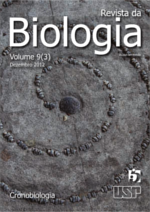Clock protein and hypothalamus-pituitary gonadal axis of female rodents
DOI:
https://doi.org/10.7594/revbio.09.03.07Keywords:
Clock protein, Ovulation, Female rats, Luteinizing hormoneAbstract
The components of hypothalamus-pituitary-gonadal axis release their products in a circadian-temporal window; this is crucial for the reproductive success in either spontaneous or inducible ovulators. The preovulatory surge of luteinizing hormone (LH) is preceded by a hypersecretion of the gonadotrophin-releasing hormone (GnRH). In rodents, it is already known that the timed, preovulatory activation of GnRH-secreting neurons depends on a complex interacting neuroendocrine mechanism involving two cyclic signals: an ovarian estradiol rise in plasma levels during the follicular phase of the estrous cycle and a neural signal from the suprachiasmatic nuclei (SCN). Evidences supporting the hypothesis that the hypothalamic-pituitary axis function depends on the integrity of an autoregulatory loop of expression of clock proteins on each of its components are increasing. This review discusses these evidencesDownloads
Download data is not yet available.
Downloads
Published
2018-04-23
Issue
Section
Ensaio
License
We ensure that our journal does not retain any copyright and that these are exclusive of the author(s) of the text. In that sense, we intend to break any restrictions to the published material and to achieve more intensely our goal of communicating science.
How to Cite
Poletini, M. de O. (2018). Clock protein and hypothalamus-pituitary gonadal axis of female rodents. Revista Da Biologia, 9(3), 41-44. https://doi.org/10.7594/revbio.09.03.07






